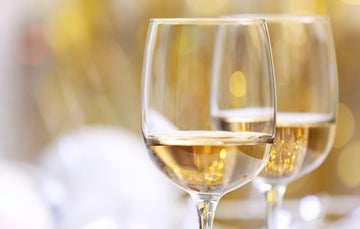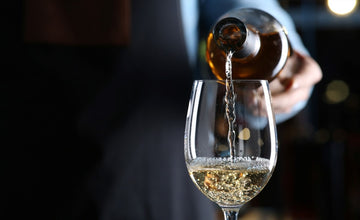Sauvignon Blanc vs. Chardonnay: What Are the Main Differences?
by Jennifer Kristensen on Jun 05, 2023

Sauvignon blanc vs chardonnay is a common conversation in the world of wine. They are two of the most popular white wines and are similar on several levels. But how do they differ? This article gives a complete explanation of the main differences between the two wines.
The Grapes
Both white wines come from French grape varieties, but not the same ones. Chardonnay grapes are green-skinned and plump with a soft but full flavor. They are often compared to the grapes used to make pinot noirs and Gouais Blancs.
They can have a rich earthy flavor with tropical and fruity notes that are bright and decadent. Chardonnay grapes are resilient and easy to grow, so they are grown all across the world. For this reason, chardonnay is easily the most common and popular variety of white wine.
Sauvignon blanc grapes aren’t drastically different, as they are also green-skinned round grapes with a deep flavor. This white wine was originally made with only wild grapes, but now, sauvignon blanc varieties are made with cultivated grapes.
The grapes used to make sauvignon blanc and cabernet sauvignon are extremely similar and share a lineage. These grapes are significantly rarer than chardonnay grapes, causing sauvignon blanc wine to be less common than chardonnay.
However, both white wines are made from only one grape variety, so there are no blends or grape combinations that may alter the flavor.
Origins and Regions
As mentioned, chardonnay is made all over the world. Some of the best regions for chardonnay include California, Oregon, New Zealand, Australia, Italy, Spain, Chile, and France. And these are just the most successful chardonnay regions.
While it’s a global wine now, it originated in the Burgundy region of France. It was given the same name as the town it comes from in the Maconnais region of southern Burgundy.
Sauv blanc has more restricted regions. The best sauvignon blanc varieties come from France, New Zealand, and California, with some vineyards in Chile and Italy. So sauvignon blanc is less widespread than chardonnay wine.
This white wine also originated in France in the Loire Valley, where most sauvignon blanc varieties still come from. It comes from the Bordeaux region of France, so the two white wines originated relatively close to one another.
Winemaking Process
Chardonnay uses a more traditional winemaking process. The Chardonnay grapes are usually fermented in oak barrels, allowing them to go through malolactic fermentation. This process reduces acidity and softens tannins, creating a smooth drinking experience.
This type of fermentation is a common technique for making red wine. Some chardonnay varieties are not fermented in oak barrels, resulting in more acidic flavors.
On the other hand, sauvignon blanc is made with more modern techniques. It’s meant to have a more acidic flavor than chardonnay, so it does not go through the malolactic fermentation process. Instead, it’s fermented in stainless steel tanks to preserve acidity.
Flavor Profile
The chardonnay flavor profile is more complex and fluid than the sauvignon blanc profile. Chardonnays fermented in oak barrels, also known as oaked chardonnays, have a softer, earthier flavor and a full body.
Unoaked chardonnays often have a more fruity flavor, taking on the taste of delicate fruits like apple, lemon, melon, pineapple, papaya, and mango. The oaked chardonnay will have a deeper, warmer, taste with notes of wood, vanilla, butter, and spices. Most chardonnays are velvety and rich, unlike sauvignon blanc, which is lighter.
Sauvignon blanc is a much fresher and crisper flavor than chardonnay. It has a citrus-forward taste with sour and bright notes of green apple, peach, gooseberry, passionfruit, and grapefruit. The taste is flowery and zesty, with an elegant lightness.
It’s not a sweet flavor, as the acidity balances out the fruitiness. Many people describe sauvignon blanc as having a bright summery flavor, whereas chardonnay is warmer and suitable for winter or fall.
Food Pairings

The last difference we want to highlight is the ideal food pairings for sauvignon blanc vs chardonnay. Because of sauvignon blanc’s acidity and crispness, it’s better suited to bright, bold flavors that are still delicate and refined.
Sauvignon blanc goes well with many summer dishes and in-season produce. But chardonnay has a richer, warmer taste that pairs perfectly with mild flavors, especially autumn foods like squash.
Below are some of the top food pairings for each wine. You’ll notice there is some overlap but also some notable differences.
Chardonnay:
- Charcuterie
- Mild and creamy cheeses (Brie, triple cream, Monterey Jack, camembert)
- Pesto or cheese sauce
- Cream or butter sauces
- Pasta dishes
- Green vegetables
- Chicken
- Shellfish
- Seafood
- Squash
Sauvignon Blanc:
- Most vegetables
- Citrus fruit
- Fresh herbs
- Chicken
- White fish
- Shellfish
- Tomato dishes
- Creamy cheese (goat, Camembert, Brie)
Alcohol Content
The alcohol content of wine varies depending on the fermentation process, aging, and other factors. Most wines have an alcohol content between 10% and 15%, and these white wines are no exception. However, chardonnay is almost always more robust than sauvignon blanc.
Chardonnay’s alcohol content falls between 13.5% and 14.5%, while sauvignon blanc is typically between 12.5% and 13.5%. You likely won’t notice the difference when drinking, but it’s a disparity between the two white wines worth noting.
Choosing the Best White Wine for You

So, where do you fall in the great debate of sauvignon blanc vs chardonnay, where do you fall? If you’re unsure, we know it can be challenging to figure out which wine is right for you. The best way to decide is to try a few brands of each and see what suits your palate!
For most people, the preference for sauvignon blanc vs chardonnay comes down to the acidity. The sharpness of sauvignon blanc can be unpleasant for people who like something smoother. But chardonnay can be uninteresting and heavy for people who enjoy brighter flavors.
Again, we recommend sampling a few varieties of chardonnay and sauvignon blanc before taking a side. You may love both!




